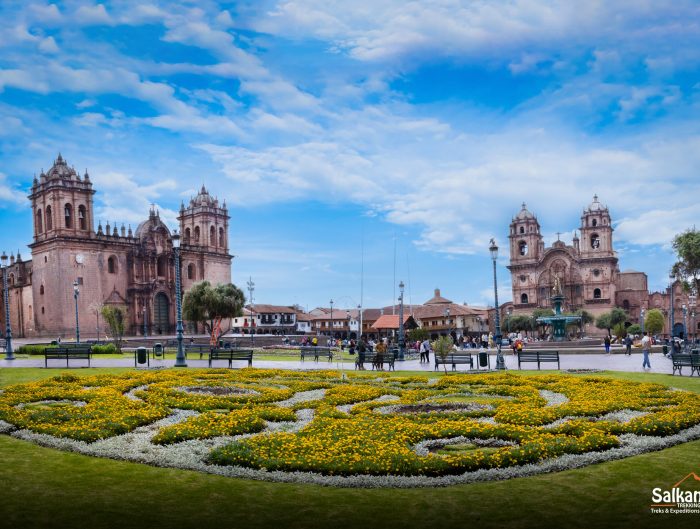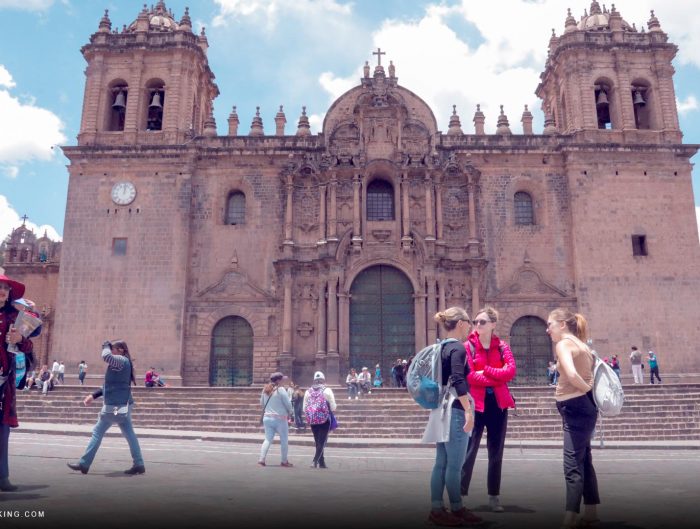Greetings, intrepid traveler! You stand on the brink of a fascinating experience in the enigmatic city of Cusco, a destination imbued with unparalleled history and culture. However, before immersing yourself in this place’s wonders, you must face a natural challenge: acclimating to the altitude. In this space, I will accompany you through adapting to Cusco’s high altitude, providing practical advice and guidance to make your adventure as enjoyable and safe as possible, allowing you to delight in every corner of this land without being hindered by a lack of oxygen.
The city of Cusco, perched at over 3,000 meters above sea level, dazzles with its colonial architecture, Inca ruins, and vibrant cultural life. However, its altitude can also challenge visitors unfamiliar with such atmospheric conditions. Acclimation thus becomes a crucial step before undertaking any activity, allowing your body to gradually adjust to the reduced oxygen pressure and avoiding possible discomfort during your stay.
I invite you to explore the secrets of acclimation in Cusco in this blog. Prepare to immerse yourself in the millennia-old history of this sacred city as you successfully adapt to its altitude, leaving behind any worries and embracing each moment with the certainty that you are ready to face any challenge that stands in your way to adventure. Welcome to Cusco, where dreams come true, and heights challenge us to surpass ourselves!


What is Acclimatization, and Why is it Important?
Acclimatization is a complex physiological phenomenon when your body gradually adapts to high altitude conditions. When you are at altitudes above 2,500 meters above sea level, such as in Cusco, your body changes to compensate for the decrease in atmospheric pressure and oxygen availability. This process involves adjustments in breathing, blood circulation, and other bodily systems to ensure an adequate oxygen supply to tissues and organs.
In Cusco, located over 3,000 meters above sea level, altitude can significantly impact your health and well-being if you do not adequately prepare. The reduction in atmospheric pressure at this altitude leads to a decrease in oxygen saturation, meaning that each breath provides less oxygen to your lungs. As a result, your body needs to work harder to obtain the same amount of oxygen, which can cause a range of unpleasant symptoms such as headache, dizziness, extreme fatigue, and even nausea.
Acclimatization is essential in Cusco because it allows you to gradually adapt to altitude conditions and minimize adverse effects on your health. Acclimating before engaging in intense physical activities such as hiking or exploring Inca ruins is crucial to reducing the risk of acute mountain sickness. This potentially serious condition can endanger your life. By allowing your body to adjust to altitude gradually, you can enjoy your stay in Cusco more safely and comfortably, making the most of every moment without unnecessary worries.
Symptoms of Altitude Sickness
When traveling to high altitudes, generally above 2,500 meters (approximately 8,200 feet), altitude sickness, also known as acute mountain sickness (AMS), can affect you. Symptoms of altitude sickness can vary in severity and may include:
- Headache: is one of the most common symptoms of altitude sickness. It can be persistent and feel like pressure in the head.
- Fatigue: feeling extremely tired or low on energy, even after adequate rest, is another common symptom.
- Dizziness and vertigo: you may experience dizziness or vertigo, especially when moving quickly.
- Nausea and vomiting: experiencing stomach discomfort and nausea are frequent symptoms of altitude sickness, although not everyone affected will experience them.
- Loss of appetite: you may lose interest in eating due to the lack of oxygen and other effects of altitude sickness.
- Insomnia or sleep disturbances: sleeping poorly at high altitudes is expected due to irregular breathing and other altitude-related factors.
- Respiratory problems: you may experience rapid breathing or shortness of breath, especially during exercise.
- Swelling of hands, feet, and face: swelling in these body areas could also be a symptom of altitude sickness.
It is important to note that not everyone experiences the same symptoms, and the severity of symptoms can vary from person to person. Additionally, you may experience altitude sickness symptoms even if you have traveled to high altitudes previously without issues. If you experience any of these symptoms affecting your ability to enjoy your trip or if the symptoms are severe or worsening, it is crucial to seek medical attention. In severe cases, altitude sickness can progress to pulmonary or cerebral edema, potentially life-threatening conditions that require immediate medical attention.


How Do I Acclimate?
Ready to immerse yourself in the unique experience offered by Cusco, Peru? Before you begin your adventure, it’s essential to be prepared for the altitude of this fascinating city. Altitude can pose challenges for your body, but with these tips, you’ll be ready to acclimate and fully enjoy your trip.
1. Take it easy and respect your body: In Cusco, your body needs time to adjust to the altitude. Don’t rush into activities; enjoy the city’s leisurely pace and take the time to acclimate before engaging in demanding activities.
2. Stay consistently hydrated: Altitude can lead to faster dehydration than average. Carry a water bottle, and take frequent sips throughout the day, even if you don’t feel thirsty.
3. Opt for a balanced and light diet: During your stay in Cusco, choose carbohydrate-rich meals such as fruits, vegetables, grains, and legumes. Avoid heavy, greasy meals that can hinder digestion and cause stomach discomfort.
4. Prioritize rest and recovery: Get enough sleep each night, and take short naps during the day if you feel fatigued. Proper rest is crucial for your body to recover from adjusting to the altitude.
5. Explore the benefits of coca leaf responsibly: Coca leaf is a traditional remedy used for centuries in the Andes to alleviate altitude symptoms. Try coca leaf infusions or suck on coca candies to help alleviate discomfort, but do so moderately and respectfully to the local culture.
6. Consult a healthcare professional before taking medication: If you’re considering taking medication to prevent or treat altitude symptoms such as altitude sickness, it’s crucial to first consult with a doctor.
7. Accept and acknowledge mild symptoms: It’s normal to experience specific altitude symptoms during the first days in Cusco. Listen to your body, rest when necessary, and follow acclimatization guidelines.
8. Remain vigilant for severe symptoms: Be alert for more severe signs indicating acute altitude illness. If you experience symptoms that are concerning, seek medical attention immediately for proper treatment.
With these tips in mind, you’ll be better prepared to successfully acclimate to the altitude of Cusco and fully enjoy your experience in this charming Peruvian city. Venture with confidence and get ready to create unforgettable memories!


Recommended Activities during Acclimatization:
During your acclimatization process in Cusco, it’s essential to maintain a leisurely pace and avoid physically demanding activities. However, you should still be active. Here are some suggestions for low-intensity activities to enjoy while adapting to the altitude:
- Exploration of the Historic Center: Stroll through the charming cobblestone streets of Cusco’s Historic Center. Admire the colonial architecture and discover the numerous temples, churches, and squares that witness the city’s rich history.
- Museum Visits: Cusco is home to various fascinating museums that offer deep insights into the region’s culture and history. To enrich your knowledge of Cusco’s past and its inhabitants, spend a few hours exploring the Pre-Columbian Art Museum, the Inca Museum, or the Regional History Museum.
- Local Markets: Immerse yourself in Cusco’s everyday life by exploring its vibrant local markets. The San Pedro Market is especially recommended, where you can enjoy fresh produce, crafts, and delicious local dishes.
- Relaxation in Plazas and Parks: Take a break in Cusco’s many plazas and parks. The Plaza de Armas is the city’s heart and a perfect spot to sit, relax, and soak in the lively atmosphere while watching people go by.
- Tasting Local Cuisine: Take advantage of your acclimatization time to indulge in delicious Cusco cuisine. Try traditional dishes such as guinea pigs, stuffed rocoto peppers, or quinoa soup at one of the local restaurants.
- Panoramic Views: Enjoy breathtaking panoramic views of the city from viewpoints such as Cristo Blanco or Sacsayhuamán. These places offer you a unique perspective of Cusco and its surroundings without requiring excessive physical effort.
These activities will allow you to immerse yourself in Cusco’s unique atmosphere while gradually adapting to the altitude. Remember to listen to your body and take the time to acclimate properly before engaging in more demanding activities. Enjoy every moment of your stay in this magical and historically rich city!
What should I do if I have altitude sickness?
During your stay in Cusco, you may experience altitude sickness known as “soroche.” This syndrome can cause uncomfortable symptoms, such as headache, nausea, fatigue, and difficulty sleeping. However, several preventive measures and natural remedies can mitigate these symptoms and make you feel more comfortable during your altitude acclimatization.
Adequate Hydration:
Staying hydrated is crucial to combat the effects of altitude sickness. Drinking plenty of water helps prevent dehydration, reduces headaches, and facilitates the body’s adaptation to altitude. In addition to water, you can opt for beverages such as herbal teas or coca leaf infusions, which also help alleviate altitude sickness symptoms.
Balanced Diet:
A balanced diet rich in nutrients can help mitigate the effects of altitude sickness. Iron-rich foods such as lean meats, legumes, and spinach promote red blood cell production and improve oxygen transport in the blood. Complex carbohydrates, such as whole grains and quinoa, are also important to maintain stable energy levels.
Adequate Rest:
Proper rest is essential during altitude acclimatization. Make sure to get enough sleep at night and take short naps during the day if you feel fatigued. Sleep helps the body recover and adapt better to altitude conditions.
Avoid Alcohol and Caffeine:
Consuming alcohol and caffeine can worsen altitude sickness symptoms, as they can cause dehydration and hinder breathing. Limit your intake of these substances during the first days in Cusco to minimize their adverse effects on your body.
Coca Leaves:
Coca leaves are a traditional remedy in the Andes to alleviate symptoms of altitude sickness. You can chew the leaves directly or consume them as tea to relieve headaches, nausea, and fatigue. However, it’s essential to consume them in moderation and respect local culture.
Preventive Medications:
Sometimes, your doctor may recommend preventive medications for altitude sickness, such as acetazolamide or ibuprofen. These medications can help prevent symptoms or reduce their severity, but you should always consult a healthcare professional before taking any medication.
These preventive measures and natural remedies can mitigate altitude sickness symptoms and allow you to enjoy comfortable and pleasant acclimatization in Cusco. Remember to listen to your body and take necessary precautions to care for your health during your trip to the Peruvian Andes.


Importance of Good Oxygenation
Proper body oxygenation plays a fundamental role in your ability to adapt to the altitude and fully enjoy your stay in Cusco. Decreased atmospheric pressure can affect the amount of oxygen available, leading to challenging symptoms such as fatigue, dizziness, and difficulty breathing. That’s why exploring various breathing techniques and exercises designed to improve body oxygenation during the acclimatization process is crucial.
Breathing Techniques:
Practicing proper breathing techniques is one of the most effective ways to improve body oxygenation. During your stay in Cusco, try deep breathing, which involves slowly inhaling through the nose, filling the lungs with air, and then exhaling gently through the mouth. This technique helps to oxygenate the blood more efficiently and reduce the sensation of breathlessness often experienced at high altitudes.
Yoga Practice:
Yoga practice can be invaluable for improving body oxygenation during acclimatization in Cusco. Combining body postures, breathing techniques, and meditation promotes greater body awareness and more profound, more conscious breathing. Yoga also helps reduce stress and anxiety, facilitating adaptation to the altitude and improving your breathing quality.
Meditation and Mindfulness:
In addition to yoga, meditation and mindfulness practices can significantly contribute to improving body oxygenation and adapting to the altitude. By dedicating time to daily meditation, you can learn to calm the mind and focus on breathing, optimizing the amount of oxygen reaching your tissues and organs. Regular mindfulness practice can also help reduce heart rate and blood circulation, improving oxygenation.
Remember that proper body oxygenation is essential for successfully acclimating to the altitude of Cusco and minimizing the adverse effects of oxygen deprivation in the body. By exploring breathing techniques, practicing yoga, meditating, and cultivating mindfulness, you can significantly improve your ability to adapt to the altitude and fully enjoy your trip to this fascinating Peruvian city.

Remember…
The altitude of Cusco presents specific health risks that are important to consider during your visit to this charming city. Below, we provide detailed information on the potential risks associated with altitude and the precautions you should take:
- Altitude Sickness or “Soroche”: Altitude sickness is one of the main risks associated with altitude in Cusco. Symptoms may include headache, nausea, dizziness, fatigue, and difficulty breathing. It’s important to recognize these symptoms and take measures to prevent or treat altitude sickness, such as resting, staying hydrated, and avoiding excessive alcohol consumption.
- Acute Mountain Sickness: In more severe cases, altitude can cause acute mountain sickness, which can be life-threatening if not adequately treated. Symptoms of this condition include confusion, difficulty breathing even at rest, persistent cough, and loss of consciousness. If you experience any of these symptoms, seek medical attention immediately.
- Pre-existing Health Problems: If you have pre-existing medical conditions such as heart or lung problems, it’s essential to consult your doctor before traveling to Cusco. Some conditions may worsen with altitude and require medication adjustments or additional precautions during your stay in the city.
- Variable Weather Conditions: Cusco can experience sudden weather changes, including heavy rain, lightning, and hail. Remember to carry a raincoat or umbrella, especially during the rainy season from November to March, and stay informed about local weather conditions.
In case of medical complications during your stay in Cusco, knowing when to seek medical help is essential. Some essential indications include:
- Severe or persistent difficulty breathing.
- Confusion or loss of consciousness.
- Chest pain or heart palpitations.
- Persistent vomiting or severe dehydration.
- Severe symptoms that do not improve with rest and hydration.
If you experience any of these symptoms, don’t hesitate to seek immediate medical attention at one of the hospitals or clinics in Cusco. Your health and safety are top priorities, so don’t ignore any warning signs!
Exploring and Acclimatizing
Exploring hiking and trekking routes near Cusco is an exciting way to immerse yourself in the stunning natural beauty of the Peruvian Andes. However, taking additional precautions is essential at high altitudes to ensure a safe and comfortable experience, especially during the acclimatization process.
Remember that you need a minimum of 3 days for proper acclimatization before venturing onto new routes in the city. Below, we offer some route suggestions and tips to make the most of these activities:
Inca Trail to Machu Picchu:
One of the most famous hiking routes in the world, the Inca Trail is an unforgettable experience that takes you through breathtaking landscapes and historic Inca ruins to the legendary lost city of Machu Picchu. This multi-day hike requires good physical condition and proper acclimatization to the altitude, so it’s essential to take the necessary time to adapt before embarking on this adventure.
Tips:
- Plan and book your spot on an organized tour with a trusted agency.
- Acclimatize properly in Cusco before starting the hike.
- Bring appropriate clothing for the weather, camping equipment, and a comfortable backpack.
- Stay hydrated throughout the hike and follow a carbohydrate-rich diet to maintain energy levels.
Humantay Lake:
Located a few hours’ drive from Cusco, Humantay Lake is a hidden gem of the Peruvian Andes that offers stunning views of snow-capped mountains and turquoise waters. The trek to the lake is a moderate hike that takes approximately 3 hours, making it an excellent choice for those who want to experience the region’s natural beauty without undertaking a strenuous hike.
Tips:
- Book a tour with a local agency, which includes transportation and a guide.
- Be prepared to walk on uneven and steep terrain, wearing appropriate footwear and trekking poles if necessary.
- Acclimatize in Cusco before the hike to minimize the risk of altitude sickness.
- Bring plenty of water, sunscreen, insect repellent, and a warm jacket, as the weather can be variable in the mountains.
Sacred Valley:
The Sacred Valley of the Incas offers hiking and trekking routes through spectacular landscapes, traditional villages, and historic Inca ruins. From short walks to more challenging trails, there are options for all levels of physical fitness and trekking experience.
Tips:
- Research and choose a route that suits your abilities and preferences.
- Consider hiring a local guide for cultural insights and to avoid getting lost.
- Remember to underestimate the altitude; acclimatize properly before the hike.
- Respect the environment and local communities, leaving only footprints and taking your waste.
Exploring hiking and trekking routes near Cusco is a truly enriching experience that allows you to connect with the nature and history of this fascinating region. By following these tips and precautions, you can enjoy a safe, comfortable, and memorable experience as you venture into the mountains of the Peruvian Andes.













Leave A Reply